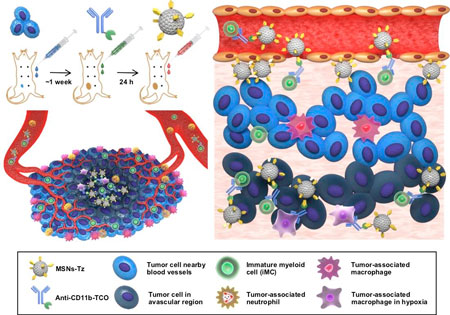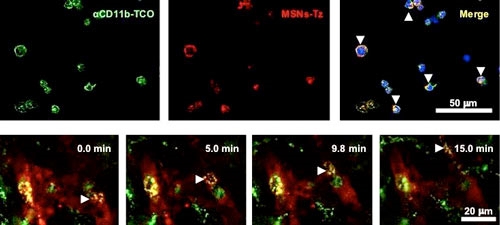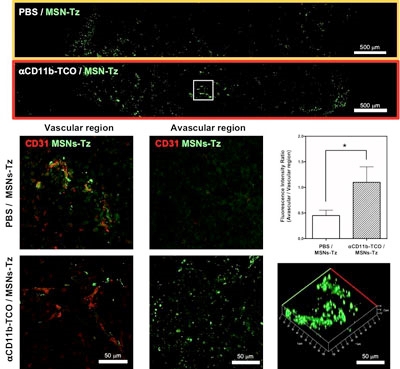|
NOVIDADES
IBS scientists reported a novel targeting strategy that allows deep tumor penetration of drug-loaded nanoparticles. They induced the linking of immune cell-targeting antibodies to drug-loaded nanoparticles on the cells, instead of taking them up in the cells or using antibody-nanoparticle conjugates. Tiny nanobots flowing through the body to repair damaged cells. Once supposed to be considered as science fiction, these microrobots are becoming a reality with a slew of experimental trials. It is generally thought that nanoparticles are so tiny that they can roam freely all over the body after administration. However, this is only partly true. In a tumor, nanoparticles can make inroads into tumors only as deep as 100 µm from the vessels. The diffusion of the nanoparticles can be also hindered by several barriers, such as dense tumor tissue, high interstitial pressure, and inhomogeneous vascular distribution. Thus, cancer cells located deep in the tissue may survive, resulting in recurrence.  Figure 1: A schematic representation of click reaction-assisted immune cell targeting (CRAIT) strategy used to enhance tumor penetration of drug-loaded NPs. (left, top) Antibodies are pre-injected to label circulating immune cells, and drug-loaded nanoparticles are subsequently administered to target the immune cells via click reaction. (left, bottom) Schematic illustration of tumor microenvironment featuring inflammatory cell recruiting and inhomogeneous blood vessel distribution. (right) Schematic illustration on the principles of CRAIT strategy. Immune cells are labeled by antibodies and subsequently tagged with nanoparticles by a click reaction. The labeled cells transport nanoparticles from tumor periphery to tumor interior. (Image: IBS)
There have been several attempts to use immune cells to deliver anti-cancer drugs to the regions inaccessible by conventional targeting approaches. Since most of them require time-consuming manipulations to extract, grow, and inject cells, this ex vivo process lowers efficacy of the treatment. Others explored ways to have antibody carrying nanoparticles target immune cells. Again, this approach proves ineffective as nanoparticles bulk up with the chemotherapy drug carried and cannot reach the designations efficiently. In a paper published in Journal of the American Chemical Society ("Deep tumor penetration of drug-loaded nanoparticles by click reaction-assisted immune cell targeting strategy"), the joint research team led by Director Taeghwan Hyeon at the Center for Nanoparticles within the Institute for Basic Science (IBS) in Daejeon, Dr. Seung-Hae Kwon at Korea Basic Science Institute in Seoul, and Prof. Nohyun Lee at Kookmin University in Seoul, South Korea reported a novel targeting strategy that allows deep tumor penetration of drug-loaded nanoparticles. They used a “click reaction”, a chemical reaction that easily joins molecular building blocks just as two pieces of a seat belt “click” to buckle. “Our idea was to induce the linking of immune cell-targeting antibodies to drug-loaded nanoparticles on the cells, instead of taking them up in the cells or using antibody-nanoparticle conjugates. Most other studies did so and failed to produce satisfactory results,” notes Professor Nohyun Lee, the corresponding author of the study.  Figure 2: (top) In vitro evaluation of click reaction between antibodies (green) and nanoparticles (red) on immune cells. (bottom) Immune cells transporting nanoparticles migrate in the blood vessels. White arrows indicate yellow immune cells as they are tagged with both antibodies (green) and nanoparticles (red). (Image: IBS)
“This click reaction-assisted immune cell targeting (CRAIT) strategy successfully “invaded” the intended areas: Real-time fluorescence imaging of the tumor tissue shows that motile immune cells transport the nanoparticles as seen in Figure 2. Compared to passive targeting, the CRAIT method brought a twofold reduction in the tumor burden in aggressive breast cancer models,” explains Dr. Soo Hong Lee, the first author of the study. The nanoparticles loaded with an anticancer drug, doxorubicin, did not affect the viability and migration of the cells.  Figure 3: (top) Representative tumors sections selected to show the distribution of nanoparticles in the non-targeted group (orange box) and the CRAIT group (red box). (middle and bottom, left and middle) Intratumoral distribution of the non-targeted group (middle) and the CRAIT group (bottom) in the vascular region (left) and the avascular region (middle). (right, middle) Ratio between vascular and region of non-targeted group and CRAIT group. (right, bottom) Three-dimensional microscopy image of the tumor section. (Image: IBS)
Since the CRAIT method relies on the click reaction, it can be applied to various delivery vehicles including micelles, liposomes, and other nanoparticles. Additionally, if adequate antibodies are available, various circulating cells can be used as delivery vehicles. Because the circulating cells are involved in various inflammatory diseases, the coverage of the CRAIT method is not limited to cancer. The versatile CRAIT method is simple, which requires modification of antibodies and nanoparticles using well-developed bio-conjugation reaction. Institute for Basic Science. Accessed: Sept 05, 2019. |
|||||||||||||||||||||||||